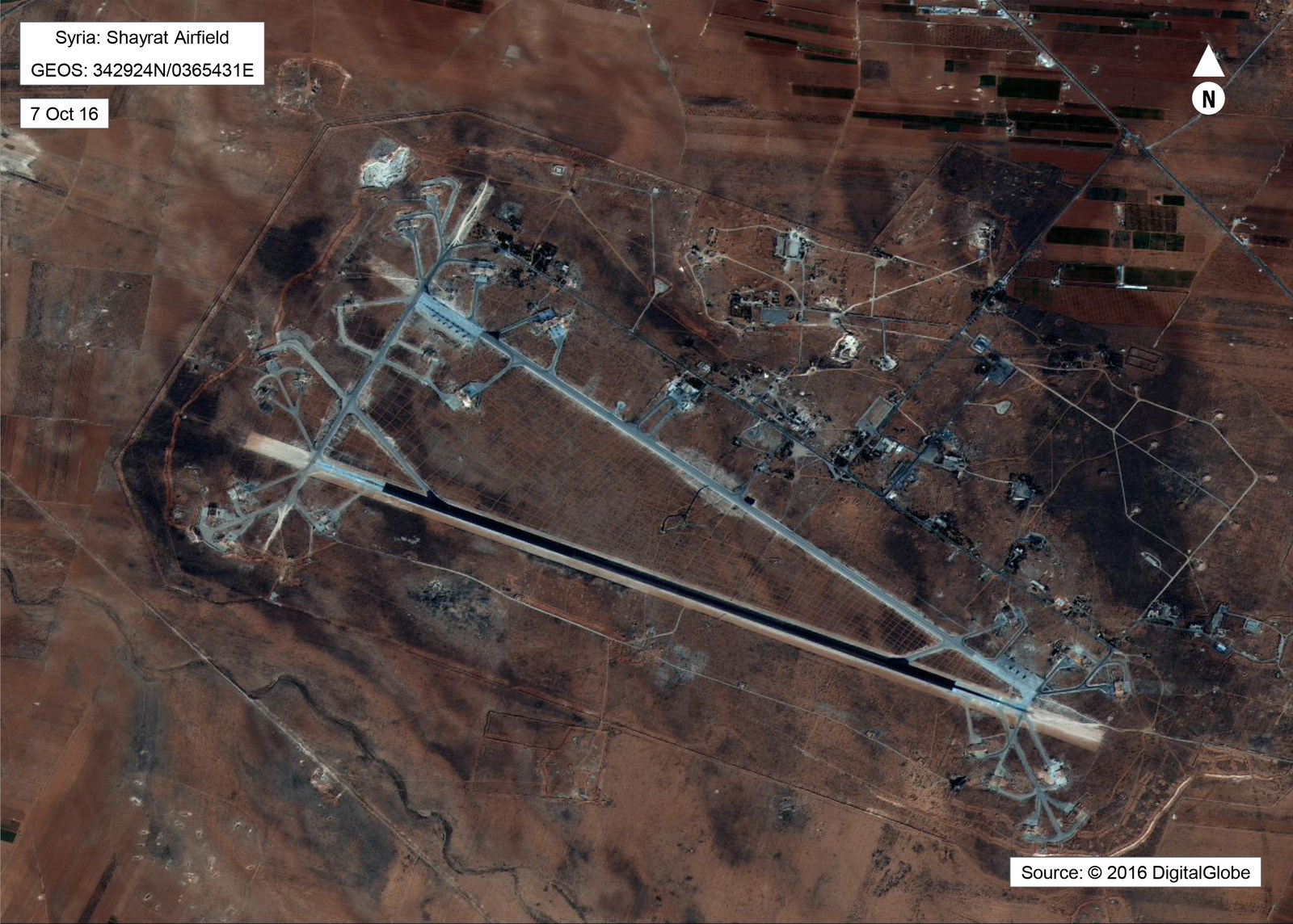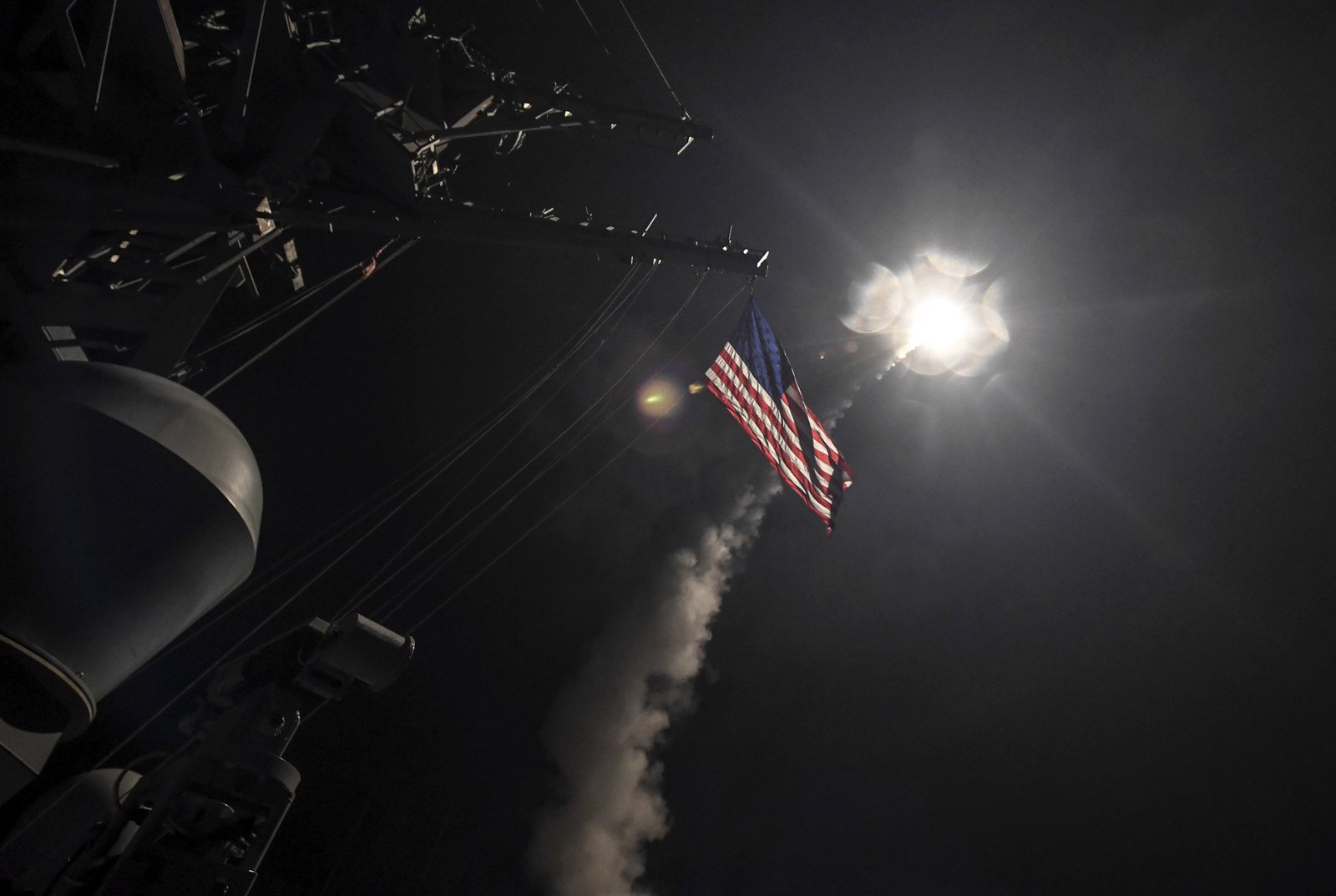
WASHINGTON — The US military launched strikes inside Syria Thursday in retaliation for the regime’s suspected chemical weapons attack earlier this week, marking the first US strikes targeting the Syrian government since the country's civil war erupted six years ago.
The US military said Thursday evening it had launched 59 Tomahawk land attack missiles targeting the Al-Shayrat air base in Homs, from where US radar captured Syrian planes carrying deadly chemical weapons taking off, attacking civilians, and returning Tuesday morning. Using two US Navy destroyers, the USS Ross and USS Porter, the attack took place over a two-minute period around 8:40 p.m. ET, or 3:40 a.m. local time, Pentagon spokesman Navy Capt Jeff Davis told reporters. The use of warships — and not manned aircraft — minimized the risk to US air personnel.
Planes, runways, hardened aircraft hangars, ammunition supply bunkers, radar, and gas lines were targeted, Davis said. The US was conducting a battlefield assessment to determine the extent of the damage that could come as early as Friday.
Davis said Russians were at the base at the time, and that there were multiple conversations with the Russians throughout the day on Thursday leading up to the strikes. He did not describe the details of those conversations other than to say they took place through existing deconfliction channels, created to make sure there were no accidents between the two nations as they launched strikes for opposing sides of the war.
The US took "extraordinary precautions" to avoid hitting areas where the Russian personnel were on the base, he said. He called the strikes a "proportional response" to Syrian use of chemical weapons. "The things we targeted are what make the base operable," he said.
Russian Foreign Minister Sergei Lavrov confirmed there had been no information about Russian casualties in the strikes. "By all accounts, there weren't any," he said Friday morning.
A short while later, Russia's Defense Ministry said only 23 of the 59 missiles reached the air base and the attack was of "low efficiency," according to the state-run Interfax news agency.
Russia Defense Ministry spokesman Maj. Gen. Igor Konashenkov said Friday that Russia would help Syria strengthen its air defenses, adding that damage done to the base was not catastrophic, according to the AP. He said 23 of the 59 missiles reached the base, they left the runway undamaged, and they destroyed six MiG fighter jets that were undergoing repairs while leaving other warplanes undamaged.
Video shows the missile launches from the USS Porter and USS Ross in the eastern Mediterranean Sea.
Given fears that the more-than-1,000 US personnel in Syria could be targeted in response to the strikes, Davis said, "We already have precautionary measures for our personnel."
Davis said he did not know what kind of Syrian aircraft was destroyed or how many, saying the US will likely have a better idea on Friday.
President Trump, in brief remarks after the strike campaign was over, said the strikes were "in this vital national security interest of the United States to prevent and deter the spread and use of deadly chemical weapons."
Defense officials told BuzzFeed News there would be no more strikes on Thursday, and one US official said there was no indication of plans for more: "We are done until another decision is made." US officials had signaled they hoped to launch a strike campaign that made clear the use of chemical weapons is unacceptable but stopped short of further escalation. The US military said that though the strikes ended Thursday, that would not mean the end of the effects of the campaign — the regime, the opposition, Russia, Iran, and US allies may all have a response.
Trump, who once vowed to not get involved in Syria’s civil war, ordered the strikes just 77 days into his term.

The lightning-fast pace of the decision to strike raised immediate questions about who inside the Trump administration was consulted before a decision of such magnitude.
The White House relied heavily on the Pentagon to draw up the military plans, and a handful of officials at the State Department were privy to the timing of the attack. But many were not, and key US allies expressed ignorance earlier on Thursday about the imminent nature of the war plans, assuming the US would first go to the UN Security Council.
"I had no idea this was going to happen so quickly," one US diplomat told BuzzFeed News.
The White House did, however, notify Israel and Jordan ahead of the attack, an Israeli defense official said.
"There need to be lines drawn as to what is accepted and what is not. Assad needs to understand what those lines are," the official told BuzzFeed News. "It is good for the world — especially our part of the world — to see the US president take decisive action."
Israeli Prime Minister Benjamin Netanyahu's office released a statement Friday praising the strikes, saying Trump sent a strong message that the use and distribution of chemical weapons won't be tolerated.
The UK and Australia, both US allies, are also among those nations to express support for the strikes.
French President François Hollande and German Chancellor Angela Merkel issued a joint statement condemning the chemical attack, saying Assad bears "full responsibility" for developments overnight.
Russian President Vladimir Putin, however, condemned the US strikes in a press statement, saying they dealt a "serious blow" to already "poor" US–Russia relations.
Putin's statement described the strikes as "an act of aggression against a sovereign state delivered in violation of international law under a far-fetched pretext. The Syrian Army has no chemical weapons."

The tactic of launching punitive strikes against the Assad regime is not controversial within the State Department. Last summer, 51 US diplomats signed a dissent memo urging then-president Barack Obama to deploy cruise missiles against the Assad regime to deter its forces' repeated ceasefire violations against Syrian rebels and civilians.
But the manner in which the Trump administration decided to carry out the strikes left even some supporters of punitive strikes fearful about whether the White House has an end game or overriding strategy.
Secretary of State Rex Tillerson, speaking to reporters in Mar-a-Lago, said: "I would not in any way attempt to extrapolate that to a change in our policy or posture relative to our military activities in Syria today. There has been no change in that status."
Despite concerns about whether key US allies were consulted, Tillerson said that the US "coordinated very carefully with our international partners."
At least 70 people, including 10 children, died and hundreds more were injured on Tuesday when a suspected sarin nerve agent attack struck the Syrian town of Khan Sheikhoun, large swaths of which are under opposition control, in the province of Idlib. Many suffocated to death as white foam formed around their mouths and noses. The regime has launched chemical attacks in the past but since a 2013 sarin attack that killed more than 1,000 people has used chlorine, which in and of itself is not an illegal material, as its agent of choice. Sarin is banned under international law.
In his comments, Trump suggested the gruesome images of the dead had moved him to order the strike.
"Even beautiful babies were cruelly murdered at this very barbaric attack," he said from Mar-a-Lago. "No child of God should ever suffer such horror."
The regime had promised to get rid of its stockpile as the result of a last-minute deal between the US and Russia to forestall a US attack on the Syrian regime in response to the 2013 chemical weapons use. But as recently as November, the Organization for the Prohibition of Chemical Weapons expressed frustration that the regime had not, in fact, destroyed its entire stockpile.
Al-Shayrat air base features two long intersecting runways that were repaved and extended by Russian engineers at the start of Moscow's intervention in Syria, flanked by dozens of hardened bunkers protecting Syrian warplanes. Satellite imagery analyzed by IHS Jane's showed the facility in heavy use by at least a dozen Russian Mi-24 and Mi-35 attack helicopters in 2016, and multiple videos taken by Russian and Syrian soldiers and posted online show both kinds of Russian-marked helicopters operating from the base.
According to the IHS Jane's report, there had been no expansion of the base's housing facilities — and one online video apparently taken by Syrian soldiers shows them driving in close proximity to the Russian aircraft — indicating that both armies live in and operate in close quarters.
Depending on the extent of the damage inflicted by the strikes, the effects could be anywhere from a minor setback to the Syrian air defenses, the one area they dominate over opposition forces, to notably undoing the Syrian air force.
The administration’s decision to launch the strikes only came about in the last 24 hours. It involved the complete reversal of a policy that Trump and his administration had just begun to lay out the previous week. The turning point appeared to be Trump’s press conference Wednesday alongside Jordan’s King Abdullah II, who was visiting Washington. Trump began by denouncing Tuesday's chemical attack but in the course of answering reporters’ questions talked himself into a more aggressive stance toward Tuesday’s attacks.
The Pentagon had no sense that it would be conducting strikes when Trump first suggested US intervention in Syria. Planning began Wednesday but full-steam preparations did not happen until Thursday, when the Pentagon and the White House spent the day exchanging ideas and counter-ideas over secure lines.
By midday Thursday, it became increasingly clear that the US was preparing to conduct strikes. There were briefings at Capitol Hill, talks with the Russians, and a heightened sense of anticipation at the Pentagon. At 4:30 p.m. ET, the service chiefs gathered with Marine Gen. Joseph Dunford, the chairman of the Joint Chiefs of Staff.
By 9 p.m., the Pentagon had confirmed the strikes. It then waited for the sun to rise in Syria to determine the effects of its first intervention against the regime.
John Hudson contributed reporting from Washington, DC; Mitch Prothero from Brussels; Sheera Frenkel from San Francisco; and Francis Whittaker from London.
